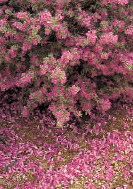
![]() chapter THREE
chapter THREE ![]()
Success with Desert Plants
Ground covers are available in different growth habits. They clump, mound, creep or trail. Clumping ground covers form upward-reaching clumps. Mounding forms create downward-reaching clumps. The foliage of creeping forms stiffly hug the ground, while trailing forms are relaxed. Trailing ground covers are adapted to grow in planters where they add interest by draping over the edges.
Grass lawns are also a form of ground cover. For more on lawns, see Small Lawns for Landscape.
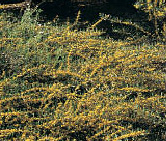
Acacia redolens 'Prostrata', prostrate acacia.
Acacia redolens ‘Prostrata’
prostrate acacia

Generally reaches 1-1/2 to 2 feet high and can spread 8 to 10 feet wide. Some mounding occurs at crown. Remove vertical growth shoots as they occur. Yellow puffball flowers bloom in spring. Rapid coverage on slopes and for erosion control. Native to Australia.
‘Desert Carpet’ is a selection with a more prostrate growth habit.
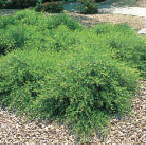
Baccharis X 'Starn' desert broom.
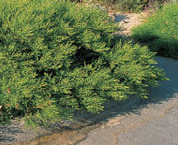
Baccharis X 'Centennial', prostrate desert broom.
Baccharis X ‘Centennial’
prostrate desert broom

A low-growing, wide-spreading hybrid between Baccharis sarothroides and B. pilularis. Grows well under both dry and moist conditions, roots deeply to prevent erosion and presents a good-looking, year-round appearance. Grows 1 to 2 feet high, spreading 3 to 6 feet wide. Plant 2 to 3 feet apart for ground cover. After plants are established, cut them back in winter to early spring to control and renew growth.
Native to southwest U.S. Baccharis X ‘Starn’ is a more uniform and compact selection.
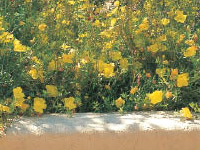
Calylophus hartwegii, calylophus.
Calylophus hartwegii
calylophus

A clumping ground cover with masses of large yellow flowers to 2 inches wide. Blooms in spring, summer and into fall. Grows 1 to 1-1/2 feet high and spreads to 2 feet wide. Leaves are narrow and bright green. Attractive when tucked in among boulders or massed in clusters. Plant in soil that has good drainage. Cut back to 8 inches high in fall after blooming ceases to reshape and renew plant for spring growth. Plants are dormant in winter. Native to southeastern Arizona.
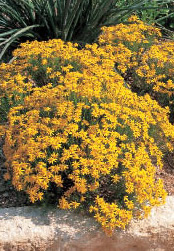
Chrysactinia mexicana, damianita.
Chrysactinia mexicana
damianita


This is a low, clumping, evergreen ground cover with a slow growth rate. Damianita bears solid yellow, daisylike flowers from April to September, and are more prolific with weekly watering. Plants grow 1 to 2 feet high with an equal spread. After a long flowering season, lightly prune spent flowers to improve appearance. Plant in soil with good drainage. Native to west Texas into New Mexico.
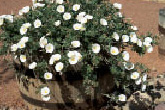
Convolvulus cneorum, silver bush morning glory.
Convolvulus cneorum
silver bush morning glory

Dwarf, compact, evergreen shrub 2 to 3 feet high and 3 feet wide, with soft silvery foliage. Masses of 1-inch, round, white to pink flowers bloom late spring and summer. Plants located in full sun have fuller, more dense growth; in partial shade form is more open. Plant in well-drained soil. Native to southern Europe.
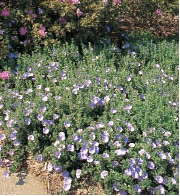
Convolvulus mauritanicus, ground morning glory.
Convolvulus mauritanicus
ground morning glory

Fast-growing, trailing evergreen perennial 1 to 1-1/2 feet high, spreading 2 feet wide. Small, round, gray-green leaves are covered with 1-inch-wide, lavender-blue flowers all summer. Plant in full sun only. Requires good soil drainage. Trim plants back in winter to renew. Native to Africa.
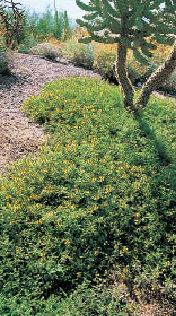
Dalea capitata, golden dalea.
Dalea capitata
golden dalea


Creeping ground cover with small, fine textured bright green leaves. Can grow to around 1 foot high, spreading to 3 feet wide. Excellent in small planters or in a rock garden. Golden blooms cover plants in spring and again in fall. It can look unappealing when dormant in winter. Cut back in late winter to rejuvenate. Native to the Chihuahuan Desert. ‘Sierra Gold’ tends to be a more prolific bloomer.
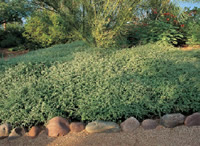
Dalea greggii, trailing indigo bush.
Dalea greggii
trailing indigo bush

This Chihuahuan Desert native is admired by gardeners seeking a low-water use ground cover. Plants grow from 1 to 1-1/2 feet high with foliage that remains a handsome gray to gray-green all year long. Dainty purple flowers bloom in spring. A single plant can spread an incredible 10 to 15 feet in diameter. Little pruning is required unless plants are located in small spaces or along curbs or walks. Once established, water need is low. Growth is more vigorous with moderate water. An ideal ground cover for erosion control. Install drip head or bubbler 1-1/2 to 2 feet from plant crown.
Gazania rigens leucolaena
trailing gazania

(G. leucolaena). Clean, silvery green foliage spreads rapidly, forming an attractive, clumping cover. Grows 6 to 10 inches high spreading up to 2 feet wide. Daisylike flowers in a selection of yellows and oranges are borne in profusion practically every month of the year. Useful on banks for erosion control. Acceptable growth in relatively poor soil. Space 1-1/2 to 2 feet apart. Not for extremely hot or sunny locations, such as western exposure. Accepts some shade. Native to South Africa.
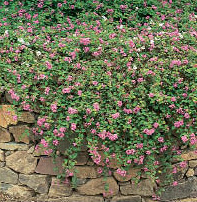
Lantana montevidensis, trailing lantana.
Lantana montevidensis
trailing lantana

Clumping, rapid-growing and free-blooming ground cover from 1-1/2 to 2 feet high spreading to 3 feet wide. Plants are blanketed with lavender flowers during the warmer seasons. If damaged by frost, prune in late winter and plants come back fast in the spring. Ideal bank cover, especially on sunny slopes, good for erosion control. Space plants 1-1/2 to 2 feet apart for ground cover. Native to South America.
‘Gold Mound’, a hybrid introduction from Texas A&M University, has rich gold flowers and does not produce seeds. Many other hybrids are available.
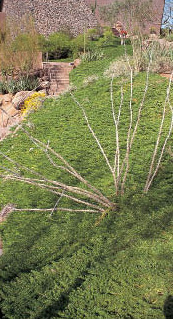
Myoporum parvifolium, myoporum.
Myoporum parvifolium
myoporum

A good ground-hugging cover for the Coachella Valley, myoporum is tough, hardy and fast-growing. It grows 3 to 4 inches high spreading wide to 6 to 9 feet. Bright green, 1-inch leaves with white flowers in summer produce a cooling effect. Branches root as they spread. Best with morning sun, which is an eastern exposure. Needs well-drained soil. Works well as cover on slopes and banks, but does not tolerate traffic. Native to Australia.
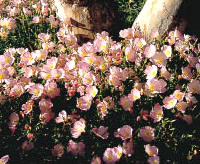
Oenothera berlandieri, Mexican evening primrose.
Oenothera berlandieri
mexican evening primrose


This plant makes a colorful, upright ground cover for small areas. Grows to 12 inches high with 1-1/2-inch, rose-pink blossoms that bloom late spring into summer. Cut back prior to bloom in late winter, then again after flowering ceases for best performance. Be aware that this plant can be invasive, and spreads by underground runners to invade nearby plantings, particularly in regularly irrigated areas. Native to the Chihuahuan Desert.
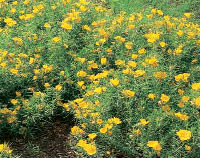
Oenothera stubbei, Chihuahuan primrose.
Oenothera stubbei
chihuahuan primrose, saltillo primrose


In past years, this plant was incorrectly labeled Oenothera drummondii, and sold as Baja primrose. It is an evergreen ground cover that reaches 6 inches high and spreads to around 3 feet wide when given regular moisture. Buttery yellow flowers to 3 inches across open in evening and fade the next morning. Blooms throughout the year, but heaviest in spring. Spreads by underground runners, making it good for erosion control. Best in partial shade to half-day of full sun. Native to the Chihuahuan Desert of northeastern Mexico.
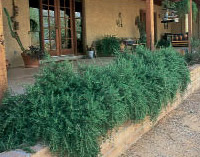
Rosmarinus officinalis 'Prostratus', prostrate rosemary.
Rosmarinus officinalis ‘Prostratus’
prostrate rosemary

Prostrate rosemary can be clumping, mounding, creeping or trailing, depending on the cultivar. Upright cultivars grow into shrub forms to 6 feet tall. Select cultivars carefully to fit garden space. All forms of rosemary can be used as the culinary herb.
Native to the Mediterranean. ‘Prostratus’ spreads 4 to 8 feet and remains less than 2 feet high. Small, light blue to violet flowers are profuse in early spring. Many new varieties are becoming available. Some have broader leaves, such as ‘Miss Jessup’, and others have brighter colored flowers such as ‘Collingwood Ingram’. ‘Huntington Carpet’ is a particularly low-growing selection that retains foliage in the center of the plant better than other creeping forms.
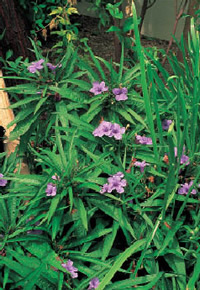
Ruellia brittoniana 'Katie', dwarf ruellia.
Ruellia brittoniana ‘Katie’
dwarf ruellia

This dwarf herbaceous plant grows to just 12 inches high, spreading in a mounding form by underground runners. Blue, bell-shaped flowers to 2 inches across bloom summer into fall, set off by medium green leaves 4 to 6 inches long. Can be used in containers, as a small-area ground cover or as a filler beneath taller plants. Native to Mexico.
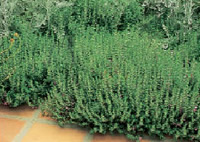
Teucrium chamaedrys 'Prostratum', creeping germander.
Teucrium chamaedrys ‘Prostratum’
creeping germander

Like rosemary, this herb can be bushy or creeping, be sure to purchase the creeping form if you want a ground cover. Unlike rosemary, the leaves are bright glossy green and rounded, and not at all needlelike. Creeping germander spreads rapidly, forming a thick cover 8 to 10 inches high. Plants root deeply and make an excellent soil binder. Plant 12 to 15 inches apart. Spikes of attractive, rosy lavender flowers bloom in spring and summer. Native to the Mediterranean.
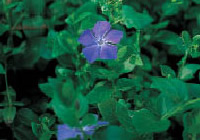
Vinca major, periwinkle.
Vinca major
periwinkle


This mounding ground cover grows rapidly to 1-1/2 feet high, spreading by runners that root as they spread to several feet wide. It’s an aggressive grower and can be invasive. Vigorous, glossy green foliage makes a wonderful background for star-shaped, lavender-blue flowers that bloom spring and summer. Plant 1-1/2 to 2 feet apart for ground cover. Native to Africa.
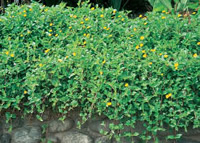
Wedelia trilobata, yellow dot.
Wedelia trilobata
yellow dot


A rapid growing, trailing ground cover to 1-1/2 feet high and 6 feet wide. Glossy, dark green leaves make an excellent backdrop to the small, golden yellow, daisylike flowers that cover the plant during the warm season. Locate carefully—this plant can be an aggressive grower if overwatered. Once established, water deeply only once a month in summer. Although it can grow in full shade, plants produce more flowers in full sun. Finches like the seeds. Native to Central and South America.